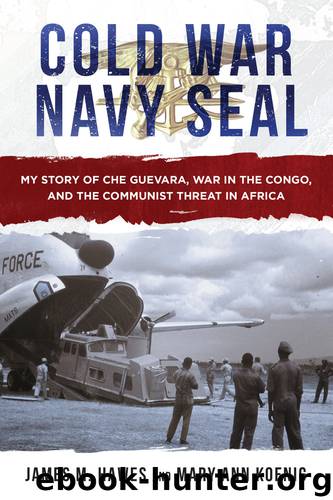Cold War Navy SEAL by James M. Hawes

Author:James M. Hawes
Language: eng
Format: epub
Publisher: Skyhorse
Published: 2018-03-19T16:00:00+00:00
Chapter Eleven
Signs and Rumors of Che
After Dern’s departure, our team shifted into a new gear. The Lobo-1 would stay in port while the Lobo-2 went out, and vice versa. The Cubans and mercenary crew ran the Swifts, the Ermans, and the PTs on interdiction raids almost on a nightly basis, and the ship’s log reflects those engagements with enemy troops from as far north as Baraka all the way back down to our home base of Albertville, hundreds of miles at a stretch.
Our Navy, with our own well-traveled and reassembled Swifts, was operating in a different kind of war. It was still a global conflict but a covert one, made up of proxy wars between the democratic west and the communist east. It was not as simple as that, of course, but our Cold War mission in the Congo, to close down supply lines that had fueled Simba rebel activity, was about weakening insurgent capabilities, holding a line against communism, and protecting America’s interests. The results of our raids were also beginning to bear unexpected fruit.
In the mid-1960s, Cold War politicking was turning into an art form. It’s difficult now to imagine the atmosphere. Unlike any other time in history, two superpowers had the ability to completely obliterate life on our planet. And they came close. After the Cuban Missile Crisis, where the world had been tipped to the brink of a nuclear exchange, the fear of a Communist take-over didn’t simply drive political anxiety, it mass-produced it. The US and the Soviets faced off in a punch and counter-punch policy of spying, intelligence gathering, and espionage that would last for another three decades and result in an ever-escalating buildup of nukes, a policy that would be termed MAD (mutually assured destruction.)
My time in the Congo occurred in the heart of this Cold War turmoil. The numbers of weapons grew and their delivery systems became increasingly sophisticated. The techniques for spying on one another evolved and improved and the specter of a communist revolution that would “topple the dominoes” attracted one side and repelled the other. The collective preoccupation of that potential event drove every government and international spying organization to step up its game, by any means necessary.
Within this atmosphere there were rumors circulating in the media and in the intelligence traffic that Che Guevara, the future iconic face of communist revolution, was on the move. He had disappeared from public life in Cuba and had not been heard from, fueling speculation not only about his whereabouts, but also about his strained relationship with Fidel Castro.
Later, Castro read a letter Che had written in which he renounced his honorary Cuban citizenship and resigned his post as the Cuban Minister of Industry, a position too passive for a man of his passionate revolutionary zeal. It was assumed that Che’s relentless desire to export the revolution would compel him look for his next battle. There had been reported sightings of him in Egypt and elsewhere in Africa, but these reports were usually unsubstantiated.
Download
This site does not store any files on its server. We only index and link to content provided by other sites. Please contact the content providers to delete copyright contents if any and email us, we'll remove relevant links or contents immediately.
Fanny Burney by Claire Harman(26254)
Empire of the Sikhs by Patwant Singh(22775)
Out of India by Michael Foss(16695)
Leonardo da Vinci by Walter Isaacson(12815)
Small Great Things by Jodi Picoult(6693)
The Six Wives Of Henry VIII (WOMEN IN HISTORY) by Fraser Antonia(5242)
The Wind in My Hair by Masih Alinejad(4852)
The Crown by Robert Lacey(4578)
The Lonely City by Olivia Laing(4577)
A Higher Loyalty: Truth, Lies, and Leadership by James Comey(4565)
The Iron Duke by The Iron Duke(4127)
Millionaire: The Philanderer, Gambler, and Duelist Who Invented Modern Finance by Janet Gleeson(4116)
Papillon (English) by Henri Charrière(3923)
Sticky Fingers by Joe Hagan(3916)
Joan of Arc by Mary Gordon(3797)
Alive: The Story of the Andes Survivors by Piers Paul Read(3743)
Stalin by Stephen Kotkin(3731)
Aleister Crowley: The Biography by Tobias Churton(3435)
Ants Among Elephants by Sujatha Gidla(3282)
